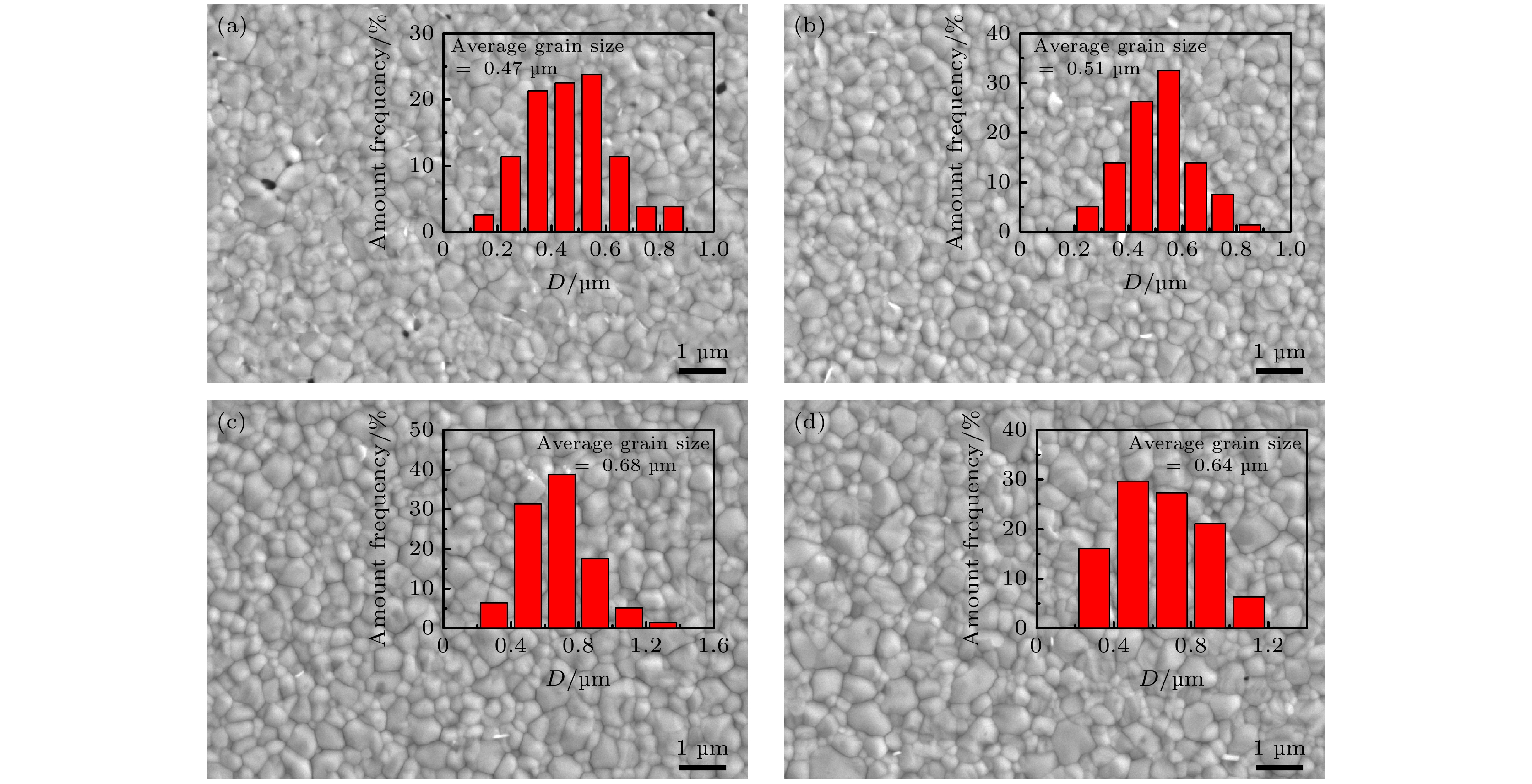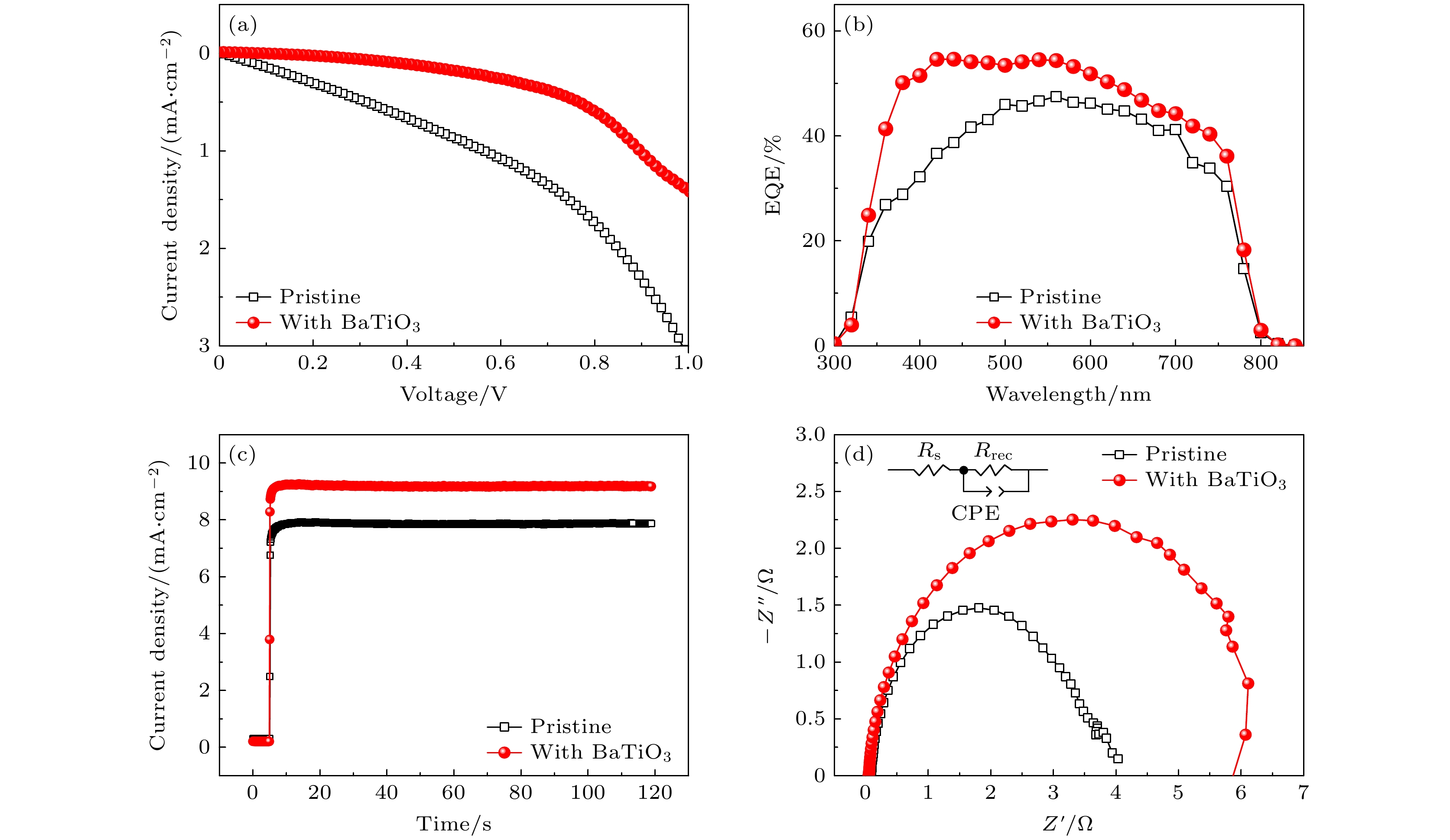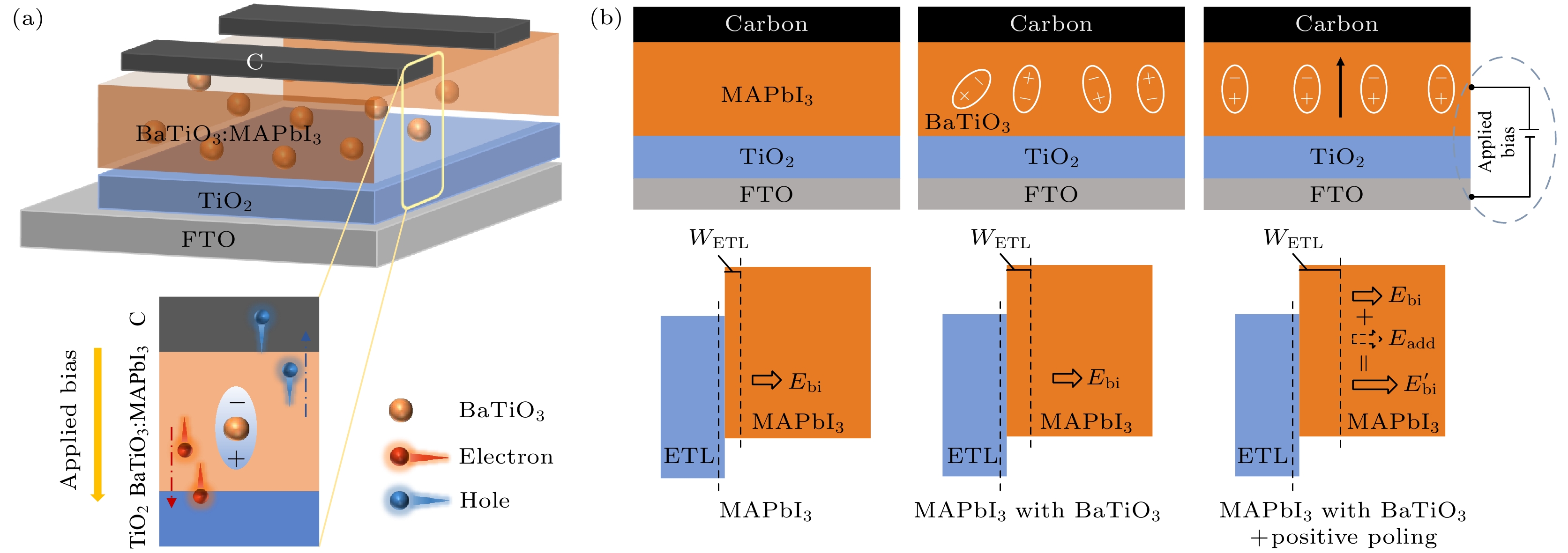-
The preparation of hybrid perovskite solar cells is expensive and environmentally demanding. Carbon-based HTL-free perovskite solar cells (C-PSCs) have attracted much attention because they replace the expensive precious metal electrode and remove the poor stability of the hole transport material. However, the improvement of efficiency is hampered by poor carrier separation and transport performance within C-PSCs, while the enhancement of the built-in electric field can improve the carrier transport performance, thus enhancing photoelectric performance. The built-in electric field can be regulated by doping. The anomalous photovoltaic effect and the built-in electric field of ferroelectric material play an important role in the field of optoelectronics. In this work, a simple and effective method is developed to improve the performance of perovskite solar cells via the combination of internal doping of ferroelectric polymer and external control of electric field. Ferroelectric material barium titanate (BaTiO3) powder is added into perovskite precursor solution as an additive to prepare C-PSCs, which can improve the perovskite film morphology, reduce the film defect density, and enhance the carrier transport performance of C-PSCs. The results show that when the addition of BaTiO3 is 1.0% (mass fraction), the perovskite film is uniform and dense, and the photoelectric conversion efficiency of the cell is the highest. After the forward voltage polarization treatment, the residual polarized electric field of ferroelectric material BaTiO3 increases the built-in electric field, which provides sufficient power for realizing carrier transport and extraction, thus inhibiting the occurrence of non-radiative recombination. At the same time, the depletion layer width is increased, and the reverse saturation current is reduced, so the cell performance is significantly improved. The optimal device efficiency is 9.02%. This work provides an efficient strategy for regulating the built-in electric field by doping perovskite absorption layer.
-
Keywords:
- perovskite solar cells /
- built-in electric field /
- ferroelectric materials /
- carrier transport
[1] Qiu L B, Ono L K, Qi Y B 2018 Mater. Today Energy 7 169
 Google Scholar
Google Scholar
[2] Kojima A, Teshima K, Shirai Y, Miyasaka T 2009 J. Am. Chem. Soc. 131 6050
 Google Scholar
Google Scholar
[3] NREL, Best Research-Cell Efficiencies: Emerging Photovoltaics https://www.nrel.gov/pv/cell-efficiency.html [2023-5-28
[4] Cai Y, Liang L S, Gao P 2018 Chin. Phys. B 27 018805
 Google Scholar
Google Scholar
[5] Jeon N J, Na H, Jung E H, Yang T Y, Lee Y G, Kim G, Shin H W, Seok S I, Lee J, Seo J 2018 Nat. Energy 3 682
 Google Scholar
Google Scholar
[6] Su H, Xiao J Y, Li Q H, Peng C, Zhang X X, Mao C, Yao Q, Lu Y J, Ku Z L, Zhong J 2020 Mater. Sci. Semicond. Proc. 107 104809
 Google Scholar
Google Scholar
[7] Etgar L, Gao P, Xue Z S, Peng Q, Chandiran A K, Liu B, Nazeeruddin M K, Gratzel M 2012 J. Am. Chem. Soc. 134 17396
 Google Scholar
Google Scholar
[8] 李家森 2021 硕士学位论文 (北京: 北京交通大学)
Li J S 2021 M. S. Thesis (Beijing: Beijing Jiaotong University
[9] Zhang L Z, Liu C, Zhang J, Li X N, Cheng C, Tian Y Q, Jen A K Y, Xu B M 2018 Adv. Mater. 30 1804028
 Google Scholar
Google Scholar
[10] Ye T, Hou Y C, Nozariasbmarz A, Yang D, Yoon J, Zheng L Y, Wang K, Wang K, Ramakrishna S, Priya S 2021 ACS Energy Lett. 6 3044
 Google Scholar
Google Scholar
[11] Wang K, Zheng L Y, Hou Y C, Nozariasbmarz A, Poudel B, Yoon J, Ye T, Yang D, Pogrebnyakov A V, Gopalan V, Priya S 2022 Joule 6 756
 Google Scholar
Google Scholar
[12] 张世宁, 张贤, 杨爽, 俞文锦, 任博文, 吴存存, 肖立新 2023 科学通报 68 39
 Google Scholar
Google Scholar
Zhang S N, Zhang X, Yang S, Yu W J, Ren B W, Wu C C, Xiao L X 2023 Chin. Sci. Bull. 68 39
 Google Scholar
Google Scholar
[13] 王明梓 2022 博士学位论文 (西安: 西北大学)
Wang M Z 2022 Ph. D. Dissertation (Xi’an: Northwest University
[14] Feng K Y, Liu X Y, Si D H, Tang X, Xing A, Osada M, Xiao P 2017 J. Power Sources 350 35
 Google Scholar
Google Scholar
[15] Chen W J, Liu S, Li Q Q, Cheng Q R, He B S, Hu Z J, Shen Y X, Chen H Y, Xu G Y, Ou X M, Yang H Y, Xi J C, Li Y W, Li Y F 2022 Adv. Mater. 34 2110482
 Google Scholar
Google Scholar
[16] Zhang C C, Wang Z K, Yuan S, Wang R, Li M, Jimoh M F, Liao L S, Yang Y 2019 Adv. Mater. 31 1902222
 Google Scholar
Google Scholar
[17] Zhou Z M, Li X, Cai M L, Xie F X, Wu Y Z, Lan Z, Yang X D, Qiang Y H, Islam A, Han L Y 2017 Adv. Energy Mater. 7 1700763
 Google Scholar
Google Scholar
[18] Euvrard J, Gunawan O, Mitzi D B 2019 Adv. Energy Mater. 9 1902706
 Google Scholar
Google Scholar
[19] Jiang Q, Zhang L Q, Wang H L, Yang X L, Meng J H, Liu H, Yin Z G, Wu J L, Zhang X W, You J B 2017 Nat. Energy 2 16177
 Google Scholar
Google Scholar
[20] Chen Q, Zhou H P, Song T B, Luo S, Hong Z R, Duan H S, Dou L T, Liu Y S, Yang Y 2014 Nano Lett. 14 4158
 Google Scholar
Google Scholar
[21] Li T T, Pan Y F, Wang Z, Xia Y D, Chen Y H, Huang W 2017 J. Mater. Chem. A 5 12602
 Google Scholar
Google Scholar
[22] Jiang Q, Chu Z N, Wang P Y, Yang X L, Liu H, Wang Y, Yin Z G, Wu J L, Zhang X W, You J B 2017 Adv. Mater. 29 1703852
 Google Scholar
Google Scholar
[23] Liu Z H, Wang L, Xie X Y 2020 J. Mater. Chem. C 8 11882
 Google Scholar
Google Scholar
[24] O’Malley K M, Li C Z, Yip H L, Jen A K Y 2012 Adv. Energy Mater. 2 82
 Google Scholar
Google Scholar
[25] Abu Laban W, Etgar L 2013 Energy Environ. Sci. 6 3249
 Google Scholar
Google Scholar
[26] Bai D L, Zhang J R, Jin Z W, Bian H, Wang K, Wang H R, Liang L, Wang Q, Liu S F 2018 ACS Energy Lett. 3 970
 Google Scholar
Google Scholar
[27] Zhu L Z, Ye J J, Zhang X H, Zheng H Y, Liu G Z, Pan X, Dai S Y 2017 J. Mater. Chem. A 5 3675
 Google Scholar
Google Scholar
[28] Hegedus S S, Shafarman W N 2004 Prog. Photovolt. 12 155
 Google Scholar
Google Scholar
[29] 朱丽杰 2018 博士学位论文 (北京: 北京交通大学)
Zhu L J 2018 Ph. D. Dissertation (Beijing: Beijing Jiaotong University
[30] Niu T Q, Lu J, Tang M C, Barrit D, Smilgies D M, Yang Z, Li J B, Fan Y Y, Luo T, McCulloch I, Amassian A, Liu S Z, Zhao K 2018 Energy Environ. Sci. 11 3358
 Google Scholar
Google Scholar
-
图 1 (a) BaTiO3浓度不同时所制备的MAPbI3薄膜的XRD衍射图谱; (b)—(d)对应BaTiO3:MAPbI3复合薄膜(110)衍射峰归一化处理(b), 强度变化(c), 半峰宽(FWHM)变化(d)
Figure 1. (a) XRD patterns of MAPbI3 films prepared with different BaTiO3 concentrations. (b)–(d) Corresponding to the (110) diffraction peak of BaTiO3:MAPbI3 composite film: (b) (110) crystal plane normalization treatment; (c) strength variation; (d) full-width at half-maximum (FWHM) variation.
图 6 MAPbI3和BaTiO3:MAPbI3基C-PSCs的(a)暗电流曲线, (b) EQE曲线, (c)稳态输出电流曲线, (d)电化学阻抗谱(暗态, 偏压0.6 V, 插图为等效电路图)
Figure 6. MAPbI3 and BaTiO3:MAPbI3 C-PSCs: (a) Dark current curves; (b) EQE curves; (c) steady-state output current curves; (d) electrochemical impedance spectroscopy (dark state, 0.6 V bias, illustrated as equivalent circuit diagram).
图 9 极化处理前后BaTiO3:MAPbI3基C-PSCs的(a) –dV/dJ与(JSC – J )–1关系曲线; (b) d(J/JSC)/dV与V – Voc关系曲线; (c) 电化学阻抗谱; (d)不同偏压的Rrec
Figure 9. BaTiO3:MAPbI3 C-PSCs before and after polarization treatment: (a) Relationship between –dV/dJ and (JSC – J )–1; (b) relationship between d(J/JSC)/dV and V – Voc; (c) electrochemical impedance spectroscopy; (d) Rrec with different bias.
表 1 不同浓度BaTiO3所制备的MAPbI3 C-PSCs的光伏性能参数
Table 1. Photovoltaic parameters of MAPbI3 C-PSCs prepared with different BaTiO3 concentrations.
Voc/V JSC/(mA·cm–2) FF/% PCE/% Pristine 0.868 10.39 48.26 4.35 0.5% 0.885 12.41 46.92 5.15 1.0% 0.904 12.72 50.99 5.87 2.0% 0.921 11.92 43.70 4.80 表 2 不同极化电压处理的BaTiO3:MAPbI3基C-PSCs的光伏性能参数
Table 2. Photovoltaic parameters of BaTiO3:MAPbI3 C-PSCs treated with different polarization voltages.
Voc/V JSC/(mA·cm–2) FF/% PCE/% Pristine 0.888 13.47 47.10 5.64 0.5 V/μm 0.989 15.72 55.66 8.65 1.0 V/μm 1.005 15.59 56.40 8.83 2.0 V/μm 0.940 14.92 50.57 7.09 表 3 极化处理前后BaTiO3:MAPbI3基C-PSCs的NA, Vbi, W值
Table 3. NA, Vbi, W values of BaTiO3:MAPbI3 C-PSCs before and after polarization treatment.
NA/cm–3 W/nm Vbi/V With BaTiO3 5.82×1015 75.23 0.926 After Poling 3.91×1015 86.30 1.002 -
[1] Qiu L B, Ono L K, Qi Y B 2018 Mater. Today Energy 7 169
 Google Scholar
Google Scholar
[2] Kojima A, Teshima K, Shirai Y, Miyasaka T 2009 J. Am. Chem. Soc. 131 6050
 Google Scholar
Google Scholar
[3] NREL, Best Research-Cell Efficiencies: Emerging Photovoltaics https://www.nrel.gov/pv/cell-efficiency.html [2023-5-28
[4] Cai Y, Liang L S, Gao P 2018 Chin. Phys. B 27 018805
 Google Scholar
Google Scholar
[5] Jeon N J, Na H, Jung E H, Yang T Y, Lee Y G, Kim G, Shin H W, Seok S I, Lee J, Seo J 2018 Nat. Energy 3 682
 Google Scholar
Google Scholar
[6] Su H, Xiao J Y, Li Q H, Peng C, Zhang X X, Mao C, Yao Q, Lu Y J, Ku Z L, Zhong J 2020 Mater. Sci. Semicond. Proc. 107 104809
 Google Scholar
Google Scholar
[7] Etgar L, Gao P, Xue Z S, Peng Q, Chandiran A K, Liu B, Nazeeruddin M K, Gratzel M 2012 J. Am. Chem. Soc. 134 17396
 Google Scholar
Google Scholar
[8] 李家森 2021 硕士学位论文 (北京: 北京交通大学)
Li J S 2021 M. S. Thesis (Beijing: Beijing Jiaotong University
[9] Zhang L Z, Liu C, Zhang J, Li X N, Cheng C, Tian Y Q, Jen A K Y, Xu B M 2018 Adv. Mater. 30 1804028
 Google Scholar
Google Scholar
[10] Ye T, Hou Y C, Nozariasbmarz A, Yang D, Yoon J, Zheng L Y, Wang K, Wang K, Ramakrishna S, Priya S 2021 ACS Energy Lett. 6 3044
 Google Scholar
Google Scholar
[11] Wang K, Zheng L Y, Hou Y C, Nozariasbmarz A, Poudel B, Yoon J, Ye T, Yang D, Pogrebnyakov A V, Gopalan V, Priya S 2022 Joule 6 756
 Google Scholar
Google Scholar
[12] 张世宁, 张贤, 杨爽, 俞文锦, 任博文, 吴存存, 肖立新 2023 科学通报 68 39
 Google Scholar
Google Scholar
Zhang S N, Zhang X, Yang S, Yu W J, Ren B W, Wu C C, Xiao L X 2023 Chin. Sci. Bull. 68 39
 Google Scholar
Google Scholar
[13] 王明梓 2022 博士学位论文 (西安: 西北大学)
Wang M Z 2022 Ph. D. Dissertation (Xi’an: Northwest University
[14] Feng K Y, Liu X Y, Si D H, Tang X, Xing A, Osada M, Xiao P 2017 J. Power Sources 350 35
 Google Scholar
Google Scholar
[15] Chen W J, Liu S, Li Q Q, Cheng Q R, He B S, Hu Z J, Shen Y X, Chen H Y, Xu G Y, Ou X M, Yang H Y, Xi J C, Li Y W, Li Y F 2022 Adv. Mater. 34 2110482
 Google Scholar
Google Scholar
[16] Zhang C C, Wang Z K, Yuan S, Wang R, Li M, Jimoh M F, Liao L S, Yang Y 2019 Adv. Mater. 31 1902222
 Google Scholar
Google Scholar
[17] Zhou Z M, Li X, Cai M L, Xie F X, Wu Y Z, Lan Z, Yang X D, Qiang Y H, Islam A, Han L Y 2017 Adv. Energy Mater. 7 1700763
 Google Scholar
Google Scholar
[18] Euvrard J, Gunawan O, Mitzi D B 2019 Adv. Energy Mater. 9 1902706
 Google Scholar
Google Scholar
[19] Jiang Q, Zhang L Q, Wang H L, Yang X L, Meng J H, Liu H, Yin Z G, Wu J L, Zhang X W, You J B 2017 Nat. Energy 2 16177
 Google Scholar
Google Scholar
[20] Chen Q, Zhou H P, Song T B, Luo S, Hong Z R, Duan H S, Dou L T, Liu Y S, Yang Y 2014 Nano Lett. 14 4158
 Google Scholar
Google Scholar
[21] Li T T, Pan Y F, Wang Z, Xia Y D, Chen Y H, Huang W 2017 J. Mater. Chem. A 5 12602
 Google Scholar
Google Scholar
[22] Jiang Q, Chu Z N, Wang P Y, Yang X L, Liu H, Wang Y, Yin Z G, Wu J L, Zhang X W, You J B 2017 Adv. Mater. 29 1703852
 Google Scholar
Google Scholar
[23] Liu Z H, Wang L, Xie X Y 2020 J. Mater. Chem. C 8 11882
 Google Scholar
Google Scholar
[24] O’Malley K M, Li C Z, Yip H L, Jen A K Y 2012 Adv. Energy Mater. 2 82
 Google Scholar
Google Scholar
[25] Abu Laban W, Etgar L 2013 Energy Environ. Sci. 6 3249
 Google Scholar
Google Scholar
[26] Bai D L, Zhang J R, Jin Z W, Bian H, Wang K, Wang H R, Liang L, Wang Q, Liu S F 2018 ACS Energy Lett. 3 970
 Google Scholar
Google Scholar
[27] Zhu L Z, Ye J J, Zhang X H, Zheng H Y, Liu G Z, Pan X, Dai S Y 2017 J. Mater. Chem. A 5 3675
 Google Scholar
Google Scholar
[28] Hegedus S S, Shafarman W N 2004 Prog. Photovolt. 12 155
 Google Scholar
Google Scholar
[29] 朱丽杰 2018 博士学位论文 (北京: 北京交通大学)
Zhu L J 2018 Ph. D. Dissertation (Beijing: Beijing Jiaotong University
[30] Niu T Q, Lu J, Tang M C, Barrit D, Smilgies D M, Yang Z, Li J B, Fan Y Y, Luo T, McCulloch I, Amassian A, Liu S Z, Zhao K 2018 Energy Environ. Sci. 11 3358
 Google Scholar
Google Scholar
Catalog
Metrics
- Abstract views: 7882
- PDF Downloads: 127
- Cited By: 0















 DownLoad:
DownLoad:










